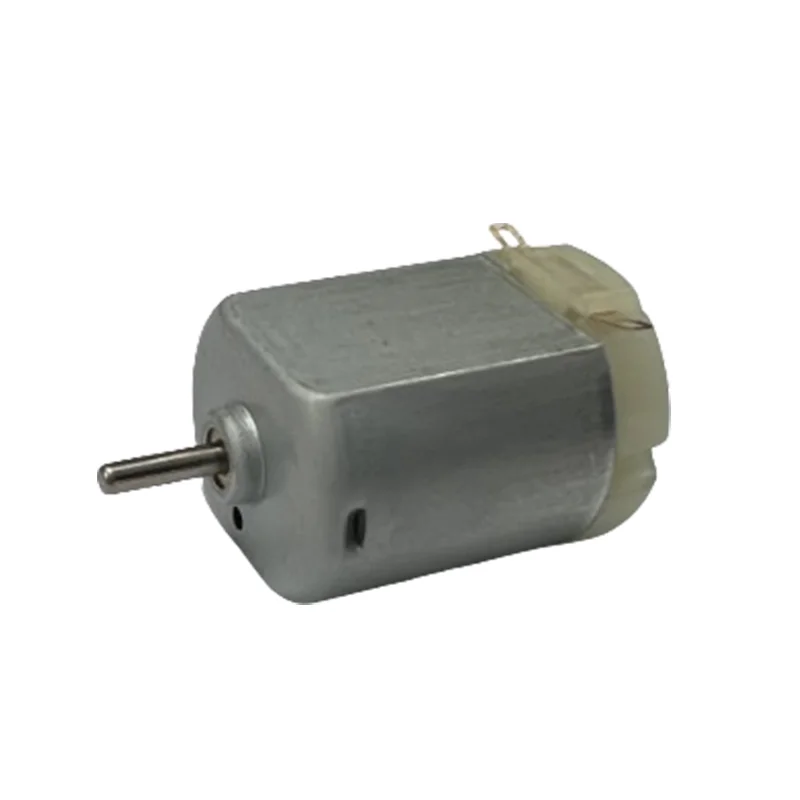Introduction to Brushed Small DC Toy Motor
Brushed small DC toy motors are compact electrical machines widely used in miniature devices, hobby projects, and educational kits. They operate by converting electrical energy into mechanical rotation through a brushed commutator system, which allows them to deliver simple, controllable motion at low voltage. Their low cost, ease of use, and versatility make them a common component in children’s toys and even small-scale engineering prototypes. In this blog post, as a high performance micro electric dc motor manufacturing factory, EcoMotor will share the advantages of brushed small dc toy motor for sale.
How Brushed Small DC Toy Motors Function
The operation of brushed DC motors relies on a straightforward principle: when current flows through the armature windings, the brushes and commutator work together to switch polarity, creating a continuous rotational force. The simplicity of this design is what makes brushed small DC toy motors attractive for mass production. Though less efficient compared to brushless counterparts, these motors are valued for their predictable performance, making them ideal for mechanical learning applications.
Variations in Miniature DC Motor Applications
Small brushed DC motors can be found in many consumer products, from vibrating mechanisms in handheld gadgets to gear-driven toy cars. Their adaptability extends to robotics education, where they provide the foundation for teaching motor control and circuit design. These motors also serve as test platforms in early engineering projects, helping students and hobbyists understand electrical-mechanical systems without requiring advanced tools or high-voltage power supplies.
Integration of Brushed Motors in Toy Manufacturing
In the toy industry, brushed small DC toy motors are the core of motion and interactivity. Manufacturers integrate these motors into cars, drones, action figures, and small appliances to simulate realistic movements. The affordability of brushed DC motors also allows large-scale toy production without significant cost increases, maintaining balance between functionality and economic feasibility. Additionally, they are often paired with gearboxes or reduction systems to adjust torque and speed, aligning with different play scenarios.

Durability and Lifespan Considerations
While brushed motors are cost-effective, their mechanical design introduces wear-and-tear challenges. The brushes and commutator degrade over time, particularly in high-friction environments, which limits their lifespan. For toy applications, this is generally acceptable since play cycles are relatively short. However, in hobby robotics or continuous-use devices, replacement or upgrade to brushless designs may be necessary. Engineers designing toys must therefore balance performance with durability to ensure consumer satisfaction.
Comparing Brushed and Brushless Toy Motors
Brushed and brushless DC motors represent two major design approaches. Brushed toy motors stand out for simplicity, lower cost, and ease of control using basic batteries and switches. Brushless designs, however, provide higher efficiency, reduced wear, and quieter operation. For small-scale toys and educational projects, brushed motors remain the default choice, but advanced robotics kits often prefer brushless alternatives for reliability and extended performance.
Educational Value of Small Brushed DC Motors
Beyond toys, brushed small DC toy motors are essential tools for teaching the principles of electromechanics. Students learn about polarity, current flow, torque generation, and mechanical-to-electrical interactions by experimenting with these motors. Their low-voltage requirements allow safe, hands-on experience, making them valuable in STEM programs worldwide. Building circuits with these motors fosters curiosity and prepares students for more complex motor systems in future engineering studies.
Innovations in Brushed Motor Design for Toys
Recent innovations have improved brushed small DC motors to better suit modern toys. Advances in materials reduce friction, extend lifespan, and minimize heat generation. Compact gear motor assemblies combine brushed motors with precision gearing, enabling smoother and more controlled movements. Noise reduction is another improvement, as quieter operation enhances the play experience for children and aligns with stricter safety and comfort standards.
Environmental and Recycling Perspectives
As sustainability becomes a central theme in manufacturing, the environmental impact of brushed DC motors is also under scrutiny. Although these motors are small, their widespread use in mass-produced toys results in significant material consumption. Recycling programs and modular toy designs that allow motor replacement rather than disposal are growing trends. Such initiatives help reduce waste and align with broader goals of sustainable product design.
Conclusion
Brushed small DC toy motors remain a cornerstone of the toy industry and educational tools. Despite limitations in durability and efficiency, their simplicity, cost-effectiveness, and wide applicability ensure they remain indispensable. From toy cars to robotics kits, these motors bridge the gap between play and learning, preparing future engineers while delivering affordable joy to children worldwide. Their continued refinement will shape both entertainment and education in the years ahead.
www.ecomotorhk.com
EcoMotor
